Sustainable Concrete: A Literature Review and Analysis of Practices
VerifiedAdded on 2022/12/01
|8
|1795
|355
Report
AI Summary
This report provides a comprehensive overview of sustainable concrete, addressing its production methods, environmental benefits, and significance in promoting eco-friendly construction practices. The report begins with an executive summary highlighting the need for changes in concrete production to reduce pollution and energy intensity, and the importance of using secondary raw materials. It then delves into a literature review, discussing the environmental impact of traditional concrete and the ongoing research to enhance sustainability through the use of alternative materials like palm oil fuel ash and rice husk cinders. The report examines the concept of sustainable concrete, its advantages such as reducing waste and greenhouse gas emissions, and the importance of considering the entire lifecycle of concrete production. It also explores the use of secondary raw materials like slag and fly ash, and their impact on concrete properties. The report concludes by emphasizing the need for sustainable concrete practices to address global environmental problems, improve the construction industry, and reduce the ecological footprint.
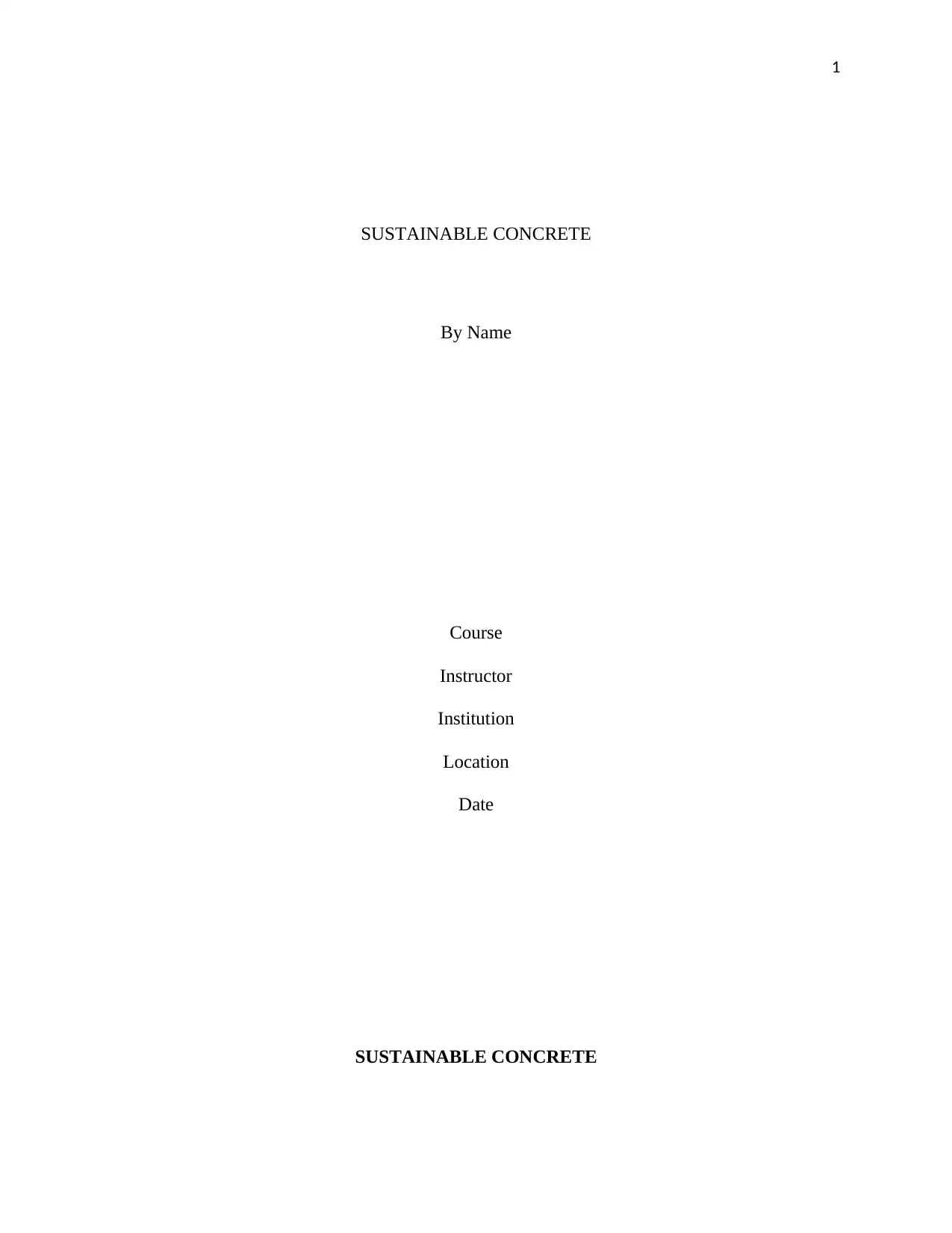
1
SUSTAINABLE CONCRETE
By Name
Course
Instructor
Institution
Location
Date
SUSTAINABLE CONCRETE
SUSTAINABLE CONCRETE
By Name
Course
Instructor
Institution
Location
Date
SUSTAINABLE CONCRETE
Paraphrase This Document
Need a fresh take? Get an instant paraphrase of this document with our AI Paraphraser
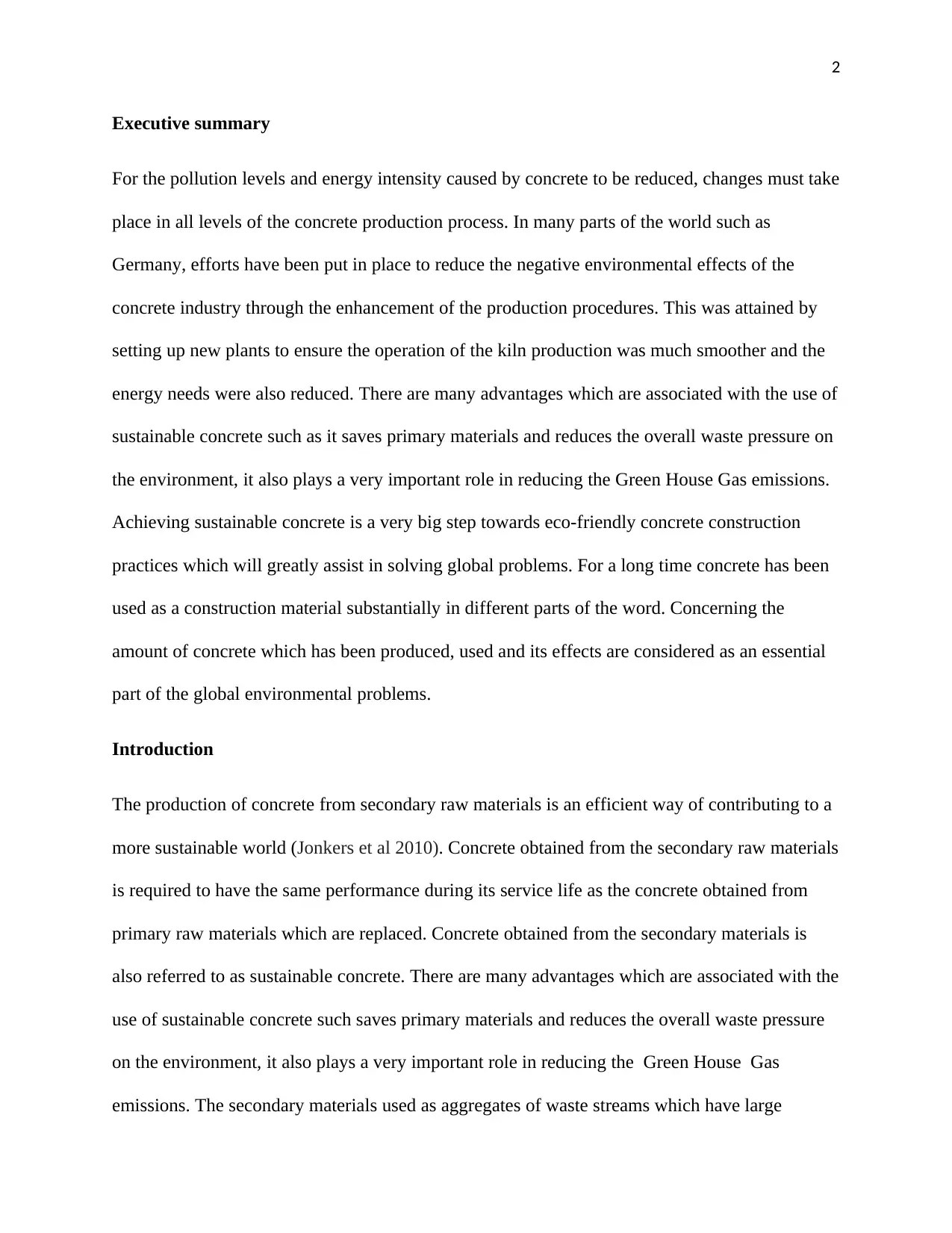
2
Executive summary
For the pollution levels and energy intensity caused by concrete to be reduced, changes must take
place in all levels of the concrete production process. In many parts of the world such as
Germany, efforts have been put in place to reduce the negative environmental effects of the
concrete industry through the enhancement of the production procedures. This was attained by
setting up new plants to ensure the operation of the kiln production was much smoother and the
energy needs were also reduced. There are many advantages which are associated with the use of
sustainable concrete such as it saves primary materials and reduces the overall waste pressure on
the environment, it also plays a very important role in reducing the Green House Gas emissions.
Achieving sustainable concrete is a very big step towards eco-friendly concrete construction
practices which will greatly assist in solving global problems. For a long time concrete has been
used as a construction material substantially in different parts of the word. Concerning the
amount of concrete which has been produced, used and its effects are considered as an essential
part of the global environmental problems.
Introduction
The production of concrete from secondary raw materials is an efficient way of contributing to a
more sustainable world (Jonkers et al 2010). Concrete obtained from the secondary raw materials
is required to have the same performance during its service life as the concrete obtained from
primary raw materials which are replaced. Concrete obtained from the secondary materials is
also referred to as sustainable concrete. There are many advantages which are associated with the
use of sustainable concrete such saves primary materials and reduces the overall waste pressure
on the environment, it also plays a very important role in reducing the Green House Gas
emissions. The secondary materials used as aggregates of waste streams which have large
Executive summary
For the pollution levels and energy intensity caused by concrete to be reduced, changes must take
place in all levels of the concrete production process. In many parts of the world such as
Germany, efforts have been put in place to reduce the negative environmental effects of the
concrete industry through the enhancement of the production procedures. This was attained by
setting up new plants to ensure the operation of the kiln production was much smoother and the
energy needs were also reduced. There are many advantages which are associated with the use of
sustainable concrete such as it saves primary materials and reduces the overall waste pressure on
the environment, it also plays a very important role in reducing the Green House Gas emissions.
Achieving sustainable concrete is a very big step towards eco-friendly concrete construction
practices which will greatly assist in solving global problems. For a long time concrete has been
used as a construction material substantially in different parts of the word. Concerning the
amount of concrete which has been produced, used and its effects are considered as an essential
part of the global environmental problems.
Introduction
The production of concrete from secondary raw materials is an efficient way of contributing to a
more sustainable world (Jonkers et al 2010). Concrete obtained from the secondary raw materials
is required to have the same performance during its service life as the concrete obtained from
primary raw materials which are replaced. Concrete obtained from the secondary materials is
also referred to as sustainable concrete. There are many advantages which are associated with the
use of sustainable concrete such saves primary materials and reduces the overall waste pressure
on the environment, it also plays a very important role in reducing the Green House Gas
emissions. The secondary materials used as aggregates of waste streams which have large
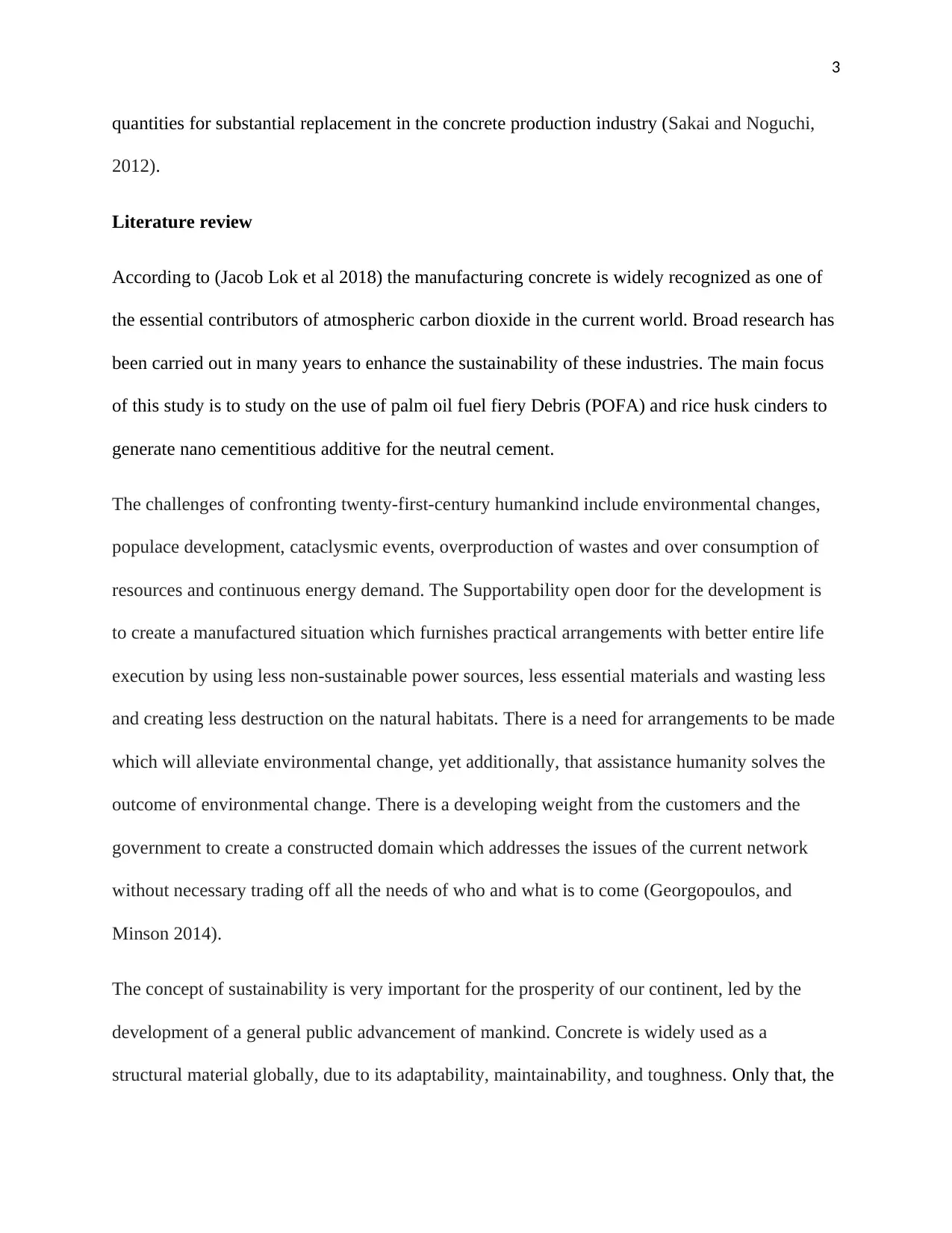
3
quantities for substantial replacement in the concrete production industry (Sakai and Noguchi,
2012).
Literature review
According to (Jacob Lok et al 2018) the manufacturing concrete is widely recognized as one of
the essential contributors of atmospheric carbon dioxide in the current world. Broad research has
been carried out in many years to enhance the sustainability of these industries. The main focus
of this study is to study on the use of palm oil fuel fiery Debris (POFA) and rice husk cinders to
generate nano cementitious additive for the neutral cement.
The challenges of confronting twenty-first-century humankind include environmental changes,
populace development, cataclysmic events, overproduction of wastes and over consumption of
resources and continuous energy demand. The Supportability open door for the development is
to create a manufactured situation which furnishes practical arrangements with better entire life
execution by using less non-sustainable power sources, less essential materials and wasting less
and creating less destruction on the natural habitats. There is a need for arrangements to be made
which will alleviate environmental change, yet additionally, that assistance humanity solves the
outcome of environmental change. There is a developing weight from the customers and the
government to create a constructed domain which addresses the issues of the current network
without necessary trading off all the needs of who and what is to come (Georgopoulos, and
Minson 2014).
The concept of sustainability is very important for the prosperity of our continent, led by the
development of a general public advancement of mankind. Concrete is widely used as a
structural material globally, due to its adaptability, maintainability, and toughness. Only that, the
quantities for substantial replacement in the concrete production industry (Sakai and Noguchi,
2012).
Literature review
According to (Jacob Lok et al 2018) the manufacturing concrete is widely recognized as one of
the essential contributors of atmospheric carbon dioxide in the current world. Broad research has
been carried out in many years to enhance the sustainability of these industries. The main focus
of this study is to study on the use of palm oil fuel fiery Debris (POFA) and rice husk cinders to
generate nano cementitious additive for the neutral cement.
The challenges of confronting twenty-first-century humankind include environmental changes,
populace development, cataclysmic events, overproduction of wastes and over consumption of
resources and continuous energy demand. The Supportability open door for the development is
to create a manufactured situation which furnishes practical arrangements with better entire life
execution by using less non-sustainable power sources, less essential materials and wasting less
and creating less destruction on the natural habitats. There is a need for arrangements to be made
which will alleviate environmental change, yet additionally, that assistance humanity solves the
outcome of environmental change. There is a developing weight from the customers and the
government to create a constructed domain which addresses the issues of the current network
without necessary trading off all the needs of who and what is to come (Georgopoulos, and
Minson 2014).
The concept of sustainability is very important for the prosperity of our continent, led by the
development of a general public advancement of mankind. Concrete is widely used as a
structural material globally, due to its adaptability, maintainability, and toughness. Only that, the
⊘ This is a preview!⊘
Do you want full access?
Subscribe today to unlock all pages.

Trusted by 1+ million students worldwide
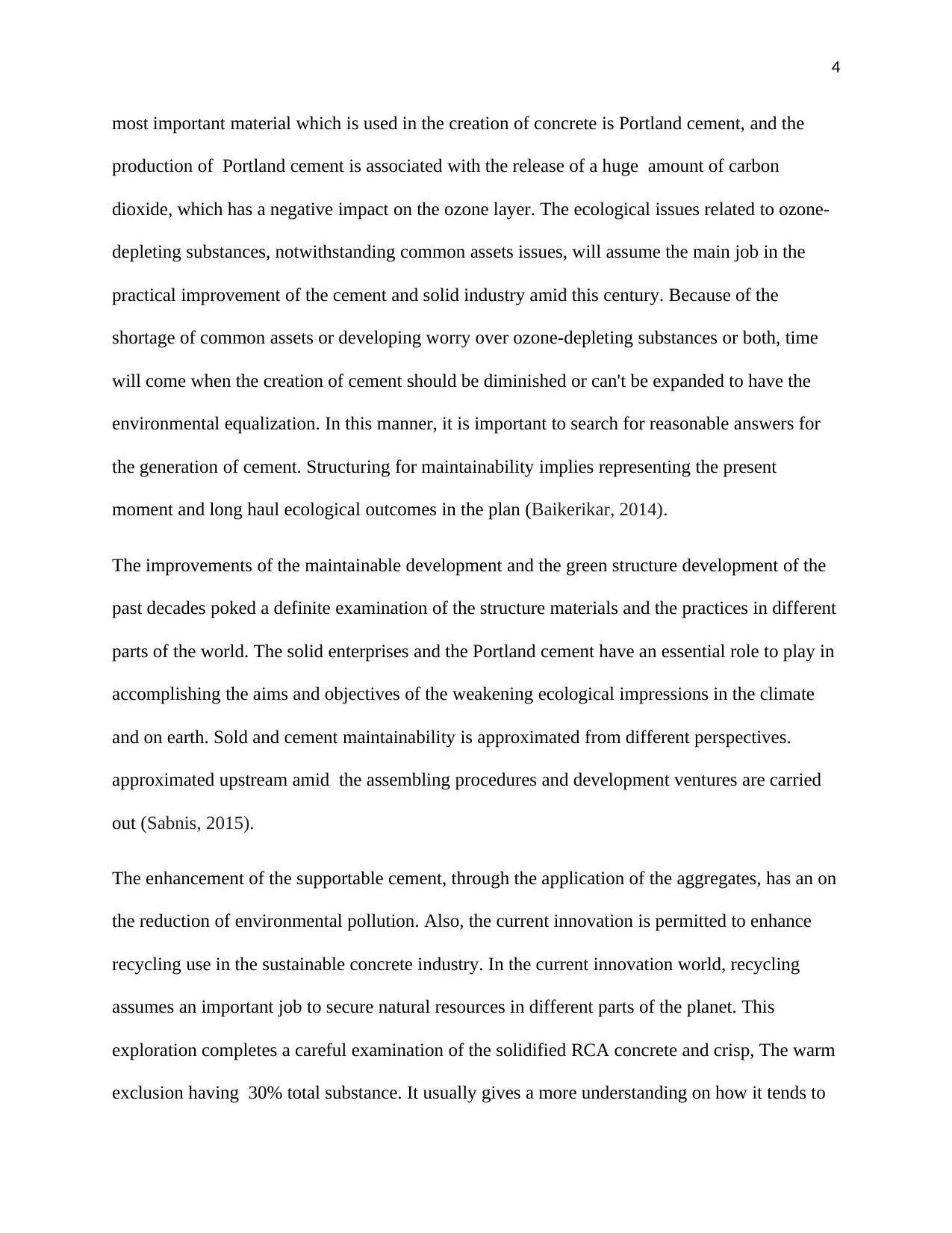
4
most important material which is used in the creation of concrete is Portland cement, and the
production of Portland cement is associated with the release of a huge amount of carbon
dioxide, which has a negative impact on the ozone layer. The ecological issues related to ozone-
depleting substances, notwithstanding common assets issues, will assume the main job in the
practical improvement of the cement and solid industry amid this century. Because of the
shortage of common assets or developing worry over ozone-depleting substances or both, time
will come when the creation of cement should be diminished or can't be expanded to have the
environmental equalization. In this manner, it is important to search for reasonable answers for
the generation of cement. Structuring for maintainability implies representing the present
moment and long haul ecological outcomes in the plan (Baikerikar, 2014).
The improvements of the maintainable development and the green structure development of the
past decades poked a definite examination of the structure materials and the practices in different
parts of the world. The solid enterprises and the Portland cement have an essential role to play in
accomplishing the aims and objectives of the weakening ecological impressions in the climate
and on earth. Sold and cement maintainability is approximated from different perspectives.
approximated upstream amid the assembling procedures and development ventures are carried
out (Sabnis, 2015).
The enhancement of the supportable cement, through the application of the aggregates, has an on
the reduction of environmental pollution. Also, the current innovation is permitted to enhance
recycling use in the sustainable concrete industry. In the current innovation world, recycling
assumes an important job to secure natural resources in different parts of the planet. This
exploration completes a careful examination of the solidified RCA concrete and crisp, The warm
exclusion having 30% total substance. It usually gives a more understanding on how it tends to
most important material which is used in the creation of concrete is Portland cement, and the
production of Portland cement is associated with the release of a huge amount of carbon
dioxide, which has a negative impact on the ozone layer. The ecological issues related to ozone-
depleting substances, notwithstanding common assets issues, will assume the main job in the
practical improvement of the cement and solid industry amid this century. Because of the
shortage of common assets or developing worry over ozone-depleting substances or both, time
will come when the creation of cement should be diminished or can't be expanded to have the
environmental equalization. In this manner, it is important to search for reasonable answers for
the generation of cement. Structuring for maintainability implies representing the present
moment and long haul ecological outcomes in the plan (Baikerikar, 2014).
The improvements of the maintainable development and the green structure development of the
past decades poked a definite examination of the structure materials and the practices in different
parts of the world. The solid enterprises and the Portland cement have an essential role to play in
accomplishing the aims and objectives of the weakening ecological impressions in the climate
and on earth. Sold and cement maintainability is approximated from different perspectives.
approximated upstream amid the assembling procedures and development ventures are carried
out (Sabnis, 2015).
The enhancement of the supportable cement, through the application of the aggregates, has an on
the reduction of environmental pollution. Also, the current innovation is permitted to enhance
recycling use in the sustainable concrete industry. In the current innovation world, recycling
assumes an important job to secure natural resources in different parts of the planet. This
exploration completes a careful examination of the solidified RCA concrete and crisp, The warm
exclusion having 30% total substance. It usually gives a more understanding on how it tends to
Paraphrase This Document
Need a fresh take? Get an instant paraphrase of this document with our AI Paraphraser
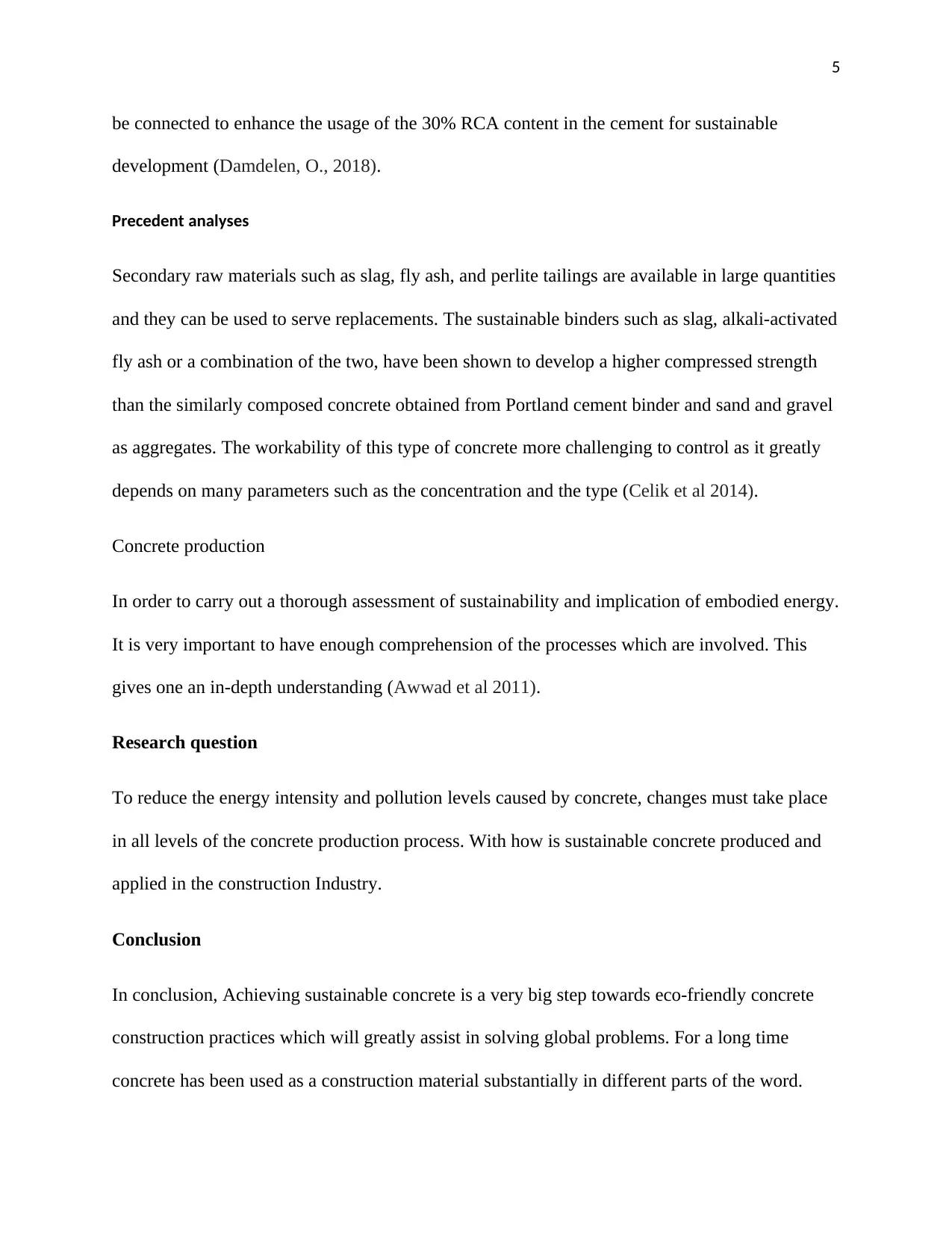
5
be connected to enhance the usage of the 30% RCA content in the cement for sustainable
development (Damdelen, O., 2018).
Precedent analyses
Secondary raw materials such as slag, fly ash, and perlite tailings are available in large quantities
and they can be used to serve replacements. The sustainable binders such as slag, alkali-activated
fly ash or a combination of the two, have been shown to develop a higher compressed strength
than the similarly composed concrete obtained from Portland cement binder and sand and gravel
as aggregates. The workability of this type of concrete more challenging to control as it greatly
depends on many parameters such as the concentration and the type (Celik et al 2014).
Concrete production
In order to carry out a thorough assessment of sustainability and implication of embodied energy.
It is very important to have enough comprehension of the processes which are involved. This
gives one an in-depth understanding (Awwad et al 2011).
Research question
To reduce the energy intensity and pollution levels caused by concrete, changes must take place
in all levels of the concrete production process. With how is sustainable concrete produced and
applied in the construction Industry.
Conclusion
In conclusion, Achieving sustainable concrete is a very big step towards eco-friendly concrete
construction practices which will greatly assist in solving global problems. For a long time
concrete has been used as a construction material substantially in different parts of the word.
be connected to enhance the usage of the 30% RCA content in the cement for sustainable
development (Damdelen, O., 2018).
Precedent analyses
Secondary raw materials such as slag, fly ash, and perlite tailings are available in large quantities
and they can be used to serve replacements. The sustainable binders such as slag, alkali-activated
fly ash or a combination of the two, have been shown to develop a higher compressed strength
than the similarly composed concrete obtained from Portland cement binder and sand and gravel
as aggregates. The workability of this type of concrete more challenging to control as it greatly
depends on many parameters such as the concentration and the type (Celik et al 2014).
Concrete production
In order to carry out a thorough assessment of sustainability and implication of embodied energy.
It is very important to have enough comprehension of the processes which are involved. This
gives one an in-depth understanding (Awwad et al 2011).
Research question
To reduce the energy intensity and pollution levels caused by concrete, changes must take place
in all levels of the concrete production process. With how is sustainable concrete produced and
applied in the construction Industry.
Conclusion
In conclusion, Achieving sustainable concrete is a very big step towards eco-friendly concrete
construction practices which will greatly assist in solving global problems. For a long time
concrete has been used as a construction material substantially in different parts of the word.
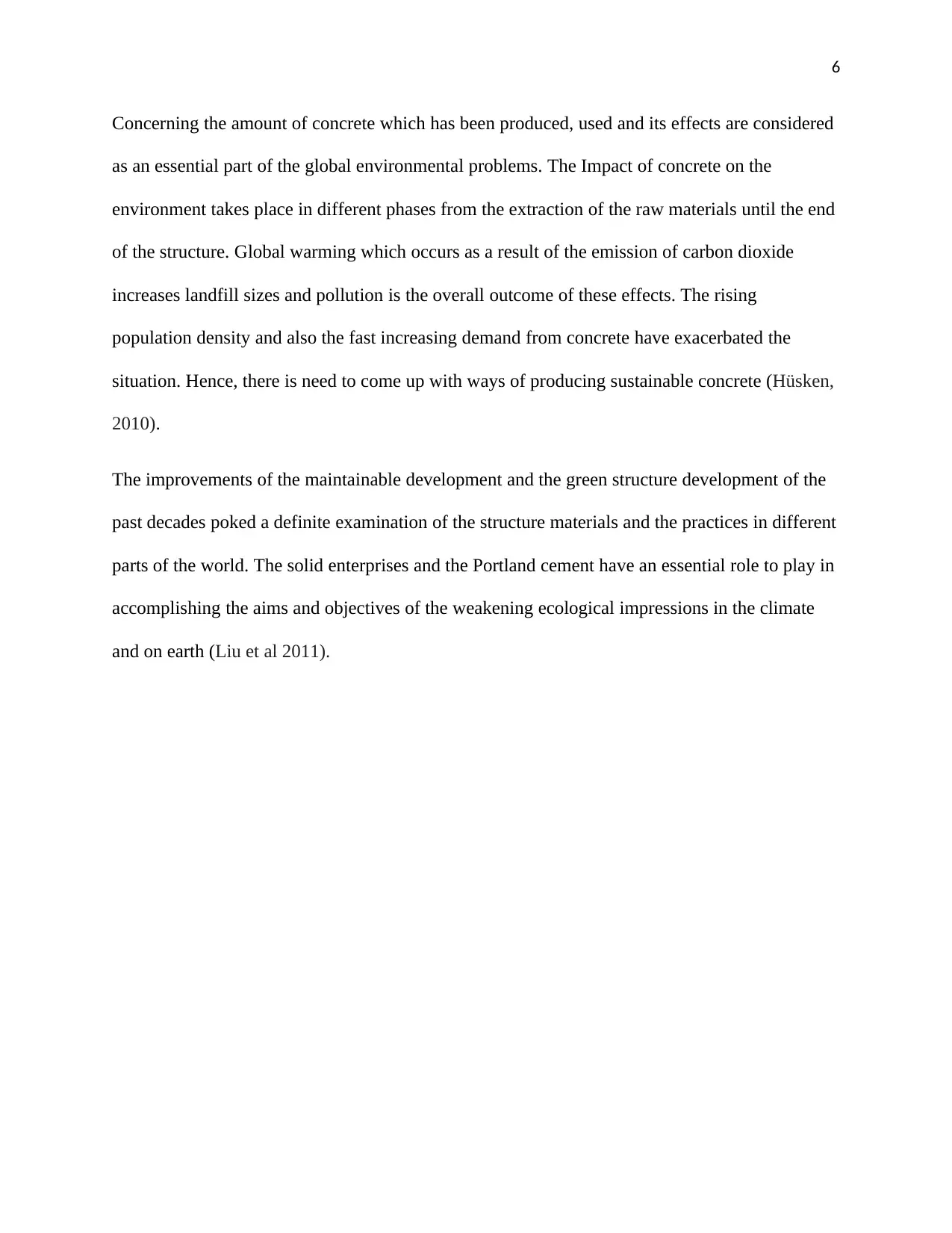
6
Concerning the amount of concrete which has been produced, used and its effects are considered
as an essential part of the global environmental problems. The Impact of concrete on the
environment takes place in different phases from the extraction of the raw materials until the end
of the structure. Global warming which occurs as a result of the emission of carbon dioxide
increases landfill sizes and pollution is the overall outcome of these effects. The rising
population density and also the fast increasing demand from concrete have exacerbated the
situation. Hence, there is need to come up with ways of producing sustainable concrete (Hüsken,
2010).
The improvements of the maintainable development and the green structure development of the
past decades poked a definite examination of the structure materials and the practices in different
parts of the world. The solid enterprises and the Portland cement have an essential role to play in
accomplishing the aims and objectives of the weakening ecological impressions in the climate
and on earth (Liu et al 2011).
Concerning the amount of concrete which has been produced, used and its effects are considered
as an essential part of the global environmental problems. The Impact of concrete on the
environment takes place in different phases from the extraction of the raw materials until the end
of the structure. Global warming which occurs as a result of the emission of carbon dioxide
increases landfill sizes and pollution is the overall outcome of these effects. The rising
population density and also the fast increasing demand from concrete have exacerbated the
situation. Hence, there is need to come up with ways of producing sustainable concrete (Hüsken,
2010).
The improvements of the maintainable development and the green structure development of the
past decades poked a definite examination of the structure materials and the practices in different
parts of the world. The solid enterprises and the Portland cement have an essential role to play in
accomplishing the aims and objectives of the weakening ecological impressions in the climate
and on earth (Liu et al 2011).
⊘ This is a preview!⊘
Do you want full access?
Subscribe today to unlock all pages.

Trusted by 1+ million students worldwide
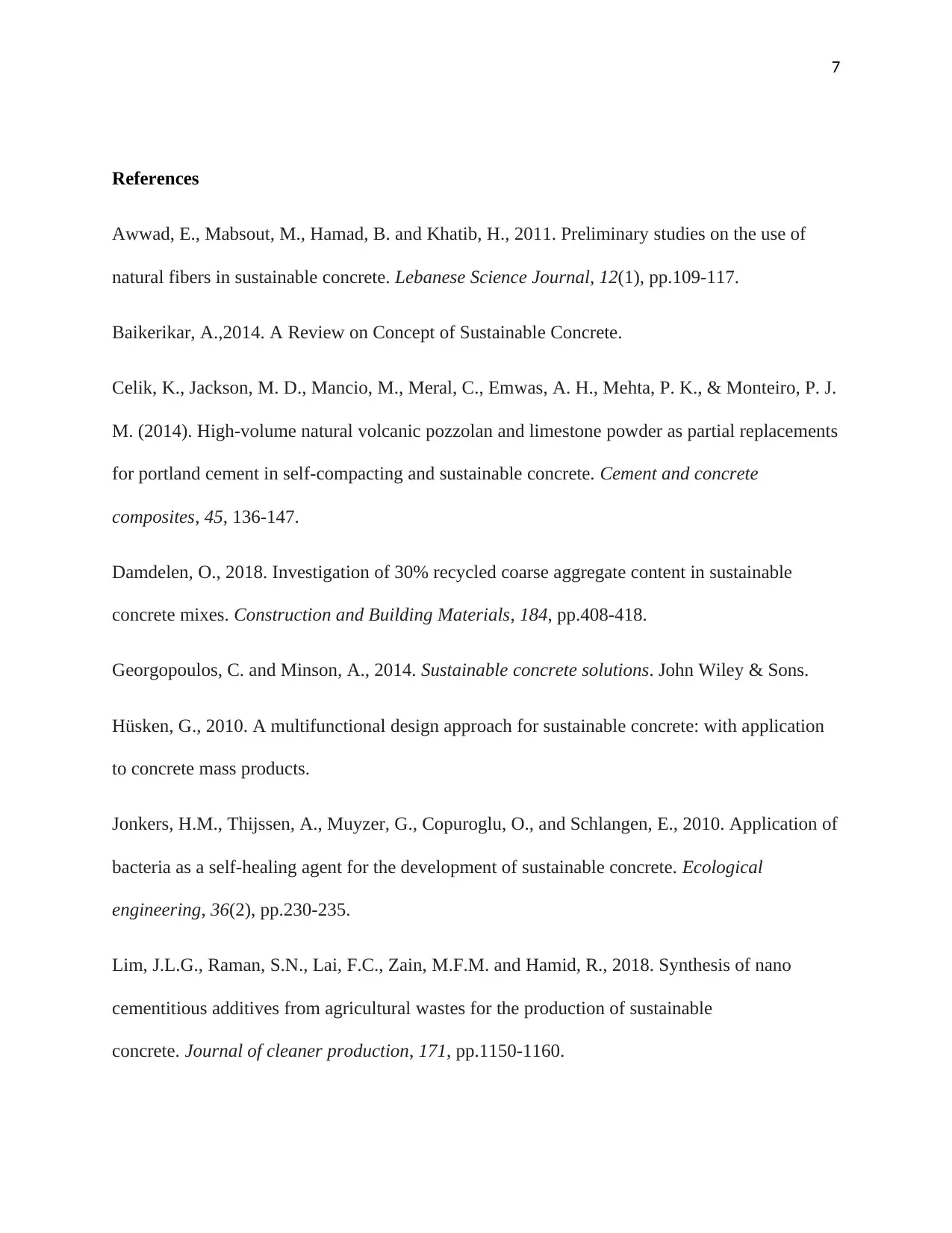
7
References
Awwad, E., Mabsout, M., Hamad, B. and Khatib, H., 2011. Preliminary studies on the use of
natural fibers in sustainable concrete. Lebanese Science Journal, 12(1), pp.109-117.
Baikerikar, A.,2014. A Review on Concept of Sustainable Concrete.
Celik, K., Jackson, M. D., Mancio, M., Meral, C., Emwas, A. H., Mehta, P. K., & Monteiro, P. J.
M. (2014). High-volume natural volcanic pozzolan and limestone powder as partial replacements
for portland cement in self-compacting and sustainable concrete. Cement and concrete
composites, 45, 136-147.
Damdelen, O., 2018. Investigation of 30% recycled coarse aggregate content in sustainable
concrete mixes. Construction and Building Materials, 184, pp.408-418.
Georgopoulos, C. and Minson, A., 2014. Sustainable concrete solutions. John Wiley & Sons.
Hüsken, G., 2010. A multifunctional design approach for sustainable concrete: with application
to concrete mass products.
Jonkers, H.M., Thijssen, A., Muyzer, G., Copuroglu, O., and Schlangen, E., 2010. Application of
bacteria as a self-healing agent for the development of sustainable concrete. Ecological
engineering, 36(2), pp.230-235.
Lim, J.L.G., Raman, S.N., Lai, F.C., Zain, M.F.M. and Hamid, R., 2018. Synthesis of nano
cementitious additives from agricultural wastes for the production of sustainable
concrete. Journal of cleaner production, 171, pp.1150-1160.
References
Awwad, E., Mabsout, M., Hamad, B. and Khatib, H., 2011. Preliminary studies on the use of
natural fibers in sustainable concrete. Lebanese Science Journal, 12(1), pp.109-117.
Baikerikar, A.,2014. A Review on Concept of Sustainable Concrete.
Celik, K., Jackson, M. D., Mancio, M., Meral, C., Emwas, A. H., Mehta, P. K., & Monteiro, P. J.
M. (2014). High-volume natural volcanic pozzolan and limestone powder as partial replacements
for portland cement in self-compacting and sustainable concrete. Cement and concrete
composites, 45, 136-147.
Damdelen, O., 2018. Investigation of 30% recycled coarse aggregate content in sustainable
concrete mixes. Construction and Building Materials, 184, pp.408-418.
Georgopoulos, C. and Minson, A., 2014. Sustainable concrete solutions. John Wiley & Sons.
Hüsken, G., 2010. A multifunctional design approach for sustainable concrete: with application
to concrete mass products.
Jonkers, H.M., Thijssen, A., Muyzer, G., Copuroglu, O., and Schlangen, E., 2010. Application of
bacteria as a self-healing agent for the development of sustainable concrete. Ecological
engineering, 36(2), pp.230-235.
Lim, J.L.G., Raman, S.N., Lai, F.C., Zain, M.F.M. and Hamid, R., 2018. Synthesis of nano
cementitious additives from agricultural wastes for the production of sustainable
concrete. Journal of cleaner production, 171, pp.1150-1160.
Paraphrase This Document
Need a fresh take? Get an instant paraphrase of this document with our AI Paraphraser
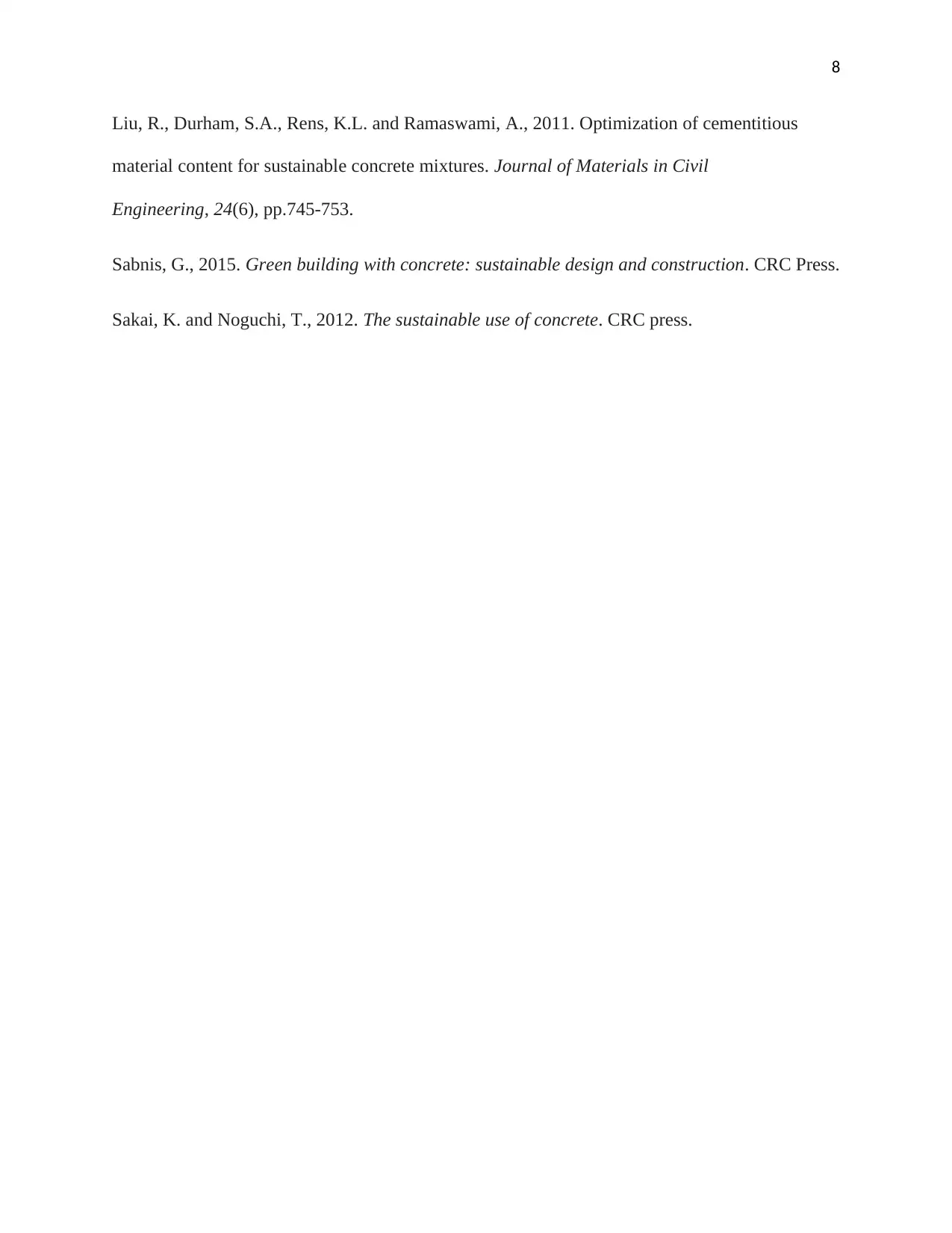
8
Liu, R., Durham, S.A., Rens, K.L. and Ramaswami, A., 2011. Optimization of cementitious
material content for sustainable concrete mixtures. Journal of Materials in Civil
Engineering, 24(6), pp.745-753.
Sabnis, G., 2015. Green building with concrete: sustainable design and construction. CRC Press.
Sakai, K. and Noguchi, T., 2012. The sustainable use of concrete. CRC press.
Liu, R., Durham, S.A., Rens, K.L. and Ramaswami, A., 2011. Optimization of cementitious
material content for sustainable concrete mixtures. Journal of Materials in Civil
Engineering, 24(6), pp.745-753.
Sabnis, G., 2015. Green building with concrete: sustainable design and construction. CRC Press.
Sakai, K. and Noguchi, T., 2012. The sustainable use of concrete. CRC press.
1 out of 8
Related Documents
Your All-in-One AI-Powered Toolkit for Academic Success.
+13062052269
info@desklib.com
Available 24*7 on WhatsApp / Email
![[object Object]](/_next/static/media/star-bottom.7253800d.svg)
Unlock your academic potential
Copyright © 2020–2025 A2Z Services. All Rights Reserved. Developed and managed by ZUCOL.





